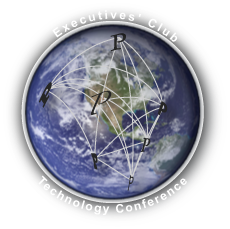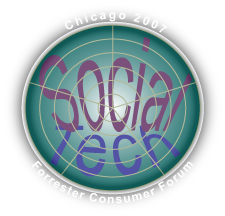Three CIOs Share Vision and Techniques for Creating the Networked Enterprise—Facebook and Tagging Creep In
 After James Owens’ luncheon address, the Executives’ Club of Chicago’s 2007-08 Technology Conference series opened with the CIO of the Year Award and a sneak preview of the 2008 Chicago Technology Outlook Survey. After James Owens’ luncheon address, the Executives’ Club of Chicago’s 2007-08 Technology Conference series opened with the CIO of the Year Award and a sneak preview of the 2008 Chicago Technology Outlook Survey.
Then a diverse panel of executives took the stage to discuss the role of the CIO in the “networked economy 2.0.” Bahman Koohestani, Senior Vice President & Chief Information Officer, Orbitz Worldwide, Paul Mankiewich, Chief Technology Officer, Alcatel-Lucent and Karenann Terrell, Chief Information Officer, Baxter International, shared their visions for the evolving role of the CIO and IT. John Gentry, Partner and Managing Director, CSC Consulting, moderated the panel discussion with aplomb. The Club’s quarterly Technology Conference took place October 16 at the Chicago Hilton.
Although the panel represented such diverse businesses as pharmaceutical giant Baxter, global network equipment provider Alcatel-Lucent and travel sensation Orbitz, all were very focused on how CIOs needed to enable a new level of innovation by fostering a new level of trust and adopting a networked model—for everything. […]
A Paradoxical Proposition, Are People More Real Where They Live Their Dreams?—Zapped by Conventional Thinking
 Gaming and virtual worlds like Second Life have been a hot topic due to their novelty and, where gaming is concerned, their Gen X and Gen Y demographics. However, early adopter marketers who have flocked to virtual worlds to create presences there have often been disappointed. Forrester’s Paul Jackson is a long-time follower of gaming and virtual worlds, and he gave a fascinating and valuable session on the status and best practices for how marketers can approach this new medium. He also gave a rough ROI picture of investing. Just like anything, if you approach virtual worlds with appropriate goals, you can benefit significantly. Gaming and virtual worlds like Second Life have been a hot topic due to their novelty and, where gaming is concerned, their Gen X and Gen Y demographics. However, early adopter marketers who have flocked to virtual worlds to create presences there have often been disappointed. Forrester’s Paul Jackson is a long-time follower of gaming and virtual worlds, and he gave a fascinating and valuable session on the status and best practices for how marketers can approach this new medium. He also gave a rough ROI picture of investing. Just like anything, if you approach virtual worlds with appropriate goals, you can benefit significantly.
An Overview of Games and Virtual Worlds
Jackson began with a history of virtual worlds and gaming, which are both inherently social (and usually sticky). Gaming began in the 1970s with multiuser Dungeons, and many early games were played on the VAX. The 1990s introduced 3-D graphics and VRML as well as massively multiuser games like Lineage, EverQuest and the World […]
… Risky, Loaded and Ready to Help You Improve Your Business
 The Global Human Capital Journal’s coverage of the Forrester Consumer Forum 2007 continues with this session on the disruptive power of customers’ Web 2.0 activity. Charlene Li, Vice President and Principal Analyst, Forrester Research, briefed the conference on the disruptive character of consumer empowerment, which she and Josh Bernoff call “groundswell.” She explained why customers were revolting, a “ladder of participation” to describe who is driving the change and some suggestions for turning revolt into reform. The Global Human Capital Journal’s coverage of the Forrester Consumer Forum 2007 continues with this session on the disruptive power of customers’ Web 2.0 activity. Charlene Li, Vice President and Principal Analyst, Forrester Research, briefed the conference on the disruptive character of consumer empowerment, which she and Josh Bernoff call “groundswell.” She explained why customers were revolting, a “ladder of participation” to describe who is driving the change and some suggestions for turning revolt into reform.
The Global Human Capital Journal published the overall conference wrap as well as in-depth coverage of several sessions. Access all through the link to the conference logo (right). Other articles will be published in the days ahead, and we invite you to subscribe to the forum’s RSS feed to be notified as they are published.
I assume that the title’s double entendre was intentional, but in any case, it captures many marketers’ attitudes toward the so-called Web 2.0 revolution. “We don’t want our customers to change. We want to maintain our marketing […]
Web 2.0 World Challenges Brands to Understand Value Propositions—Inner Human Desire Is the Keel
 The Global Human Capital Journal’s coverage of the Forrester Consumer Forum 2007 continues with this session on Playboy Enterprises’ experience with integrating social technologies into its multichannel offerings. Christie Hefner, Chairman and CEO, gave a doubly-valuable presentation because she addressed her company’s journey to online customer engagement and explained how Playboy’s transition was affecting its advertisers. It was obvious that she is a leader who rolls up her sleeves and understands her business. The Global Human Capital Journal’s coverage of the Forrester Consumer Forum 2007 continues with this session on Playboy Enterprises’ experience with integrating social technologies into its multichannel offerings. Christie Hefner, Chairman and CEO, gave a doubly-valuable presentation because she addressed her company’s journey to online customer engagement and explained how Playboy’s transition was affecting its advertisers. It was obvious that she is a leader who rolls up her sleeves and understands her business.
The Global Human Capital Journal published the overall conference wrap as well as in-depth coverage of several sessions. Access all through the link to the conference logo. Other articles will be published in the days ahead, and we invite you to subscribe to the forum’s RSS feed to be notified as they are published.
Hefner’s advice for senior marketers was to remember that human beings are not fundamentally being changed, even though the way in which they relate and communicate may be changing dramatically. Our humanity, desires and impulses are a constant. Moreover, the […]
Case Studies Presage Imminent Adoption of Social Technologies—Emerging Markets Prize In Balance
 A who’s who of global marketing executives convened on the Hilton Chicago October 11-12, 2007 for two days of cramming on social networks, emerging technology and transformation. It certainly felt like an inflection point: analysts’ insights and technology pioneers’ zeal were tempered by corporate stories in the trenches. Based on my experience with previous adoption curves, I predict a significant jump in Web 2.0 adoption by corporations next year. A who’s who of global marketing executives convened on the Hilton Chicago October 11-12, 2007 for two days of cramming on social networks, emerging technology and transformation. It certainly felt like an inflection point: analysts’ insights and technology pioneers’ zeal were tempered by corporate stories in the trenches. Based on my experience with previous adoption curves, I predict a significant jump in Web 2.0 adoption by corporations next year.
Depending on your industry, the next six months will be your last chance to be early to market. As success stories become more widespread and executives realize that Web 2.0 has very low barriers to adoption due to the social Zeitgeist and a relatively low price point, the use of social technologies will rapidly become mainstream. The main barrier to adoption is cultural resistance and organizational inertia.
Although this was not a technology conference, in my conclusions, I will provide some insights about why and how Web 2.0 represents a fundamentally new technology value proposition that makes it […]
Over-Publicized Problems and Unusual Opportunities—A Way to Monetize Collaboration?
 Financial Markets World held its conference, Web 2.0/Enterprise 2.0 in the Capital Markets Industry, in New York City on 17 September 2007. Invited as a panelist on the bleeding edge track, “Web 3.0: Where Are We Going,” I nonetheless had time to scribble some notes to cover some of the sessions. Financial Markets World held its conference, Web 2.0/Enterprise 2.0 in the Capital Markets Industry, in New York City on 17 September 2007. Invited as a panelist on the bleeding edge track, “Web 3.0: Where Are We Going,” I nonetheless had time to scribble some notes to cover some of the sessions.
Enterprise 2.0 is being adopted by investment banks and the capital markets industry, but adoption is being dampened by two flies in the ointment: 1) the industry is highly regulated, and compliance forces firms to have control of their data, which means CIOs are hesitant to try new technology that may introduce risk; 2) enterprise 2.0 doesn’t yet have a locked and loaded business case. It’s early, and all conference sessions reflected that.
The Global Human Capital Journal’s coverage comprises summaries of all the sessions, as well as more in-depth coverage of three of the sessions. To access all the articles in one click, use the Financial Markets World tag. This article contains the summaries as well as my analysis and conclusions of […]
Adoption Weakened by Compliance Risk and “So Obvious It’s Invisible” Value Proposition
 The Global Human Capital Journal’s coverage of Financial Markets World’s Web 2.0 in the Capital Markets Industry conference continues. In this session, Dion Hinchcliffe, a leading writer and consultant in Web 2.0 and Enterprise 2.0, described how capital markets firms were adopting Enterprise 2.0. After some general points on enterprise 2.0 adoption, he referenced early work of Dresdner Kleinwort, AOL, T. Rowe Price, Wells Fargo and JP Morgan. As usual, I’ll summarize his remarks before sharing my analysis and conclusions. The Global Human Capital Journal’s coverage of Financial Markets World’s Web 2.0 in the Capital Markets Industry conference continues. In this session, Dion Hinchcliffe, a leading writer and consultant in Web 2.0 and Enterprise 2.0, described how capital markets firms were adopting Enterprise 2.0. After some general points on enterprise 2.0 adoption, he referenced early work of Dresdner Kleinwort, AOL, T. Rowe Price, Wells Fargo and JP Morgan. As usual, I’ll summarize his remarks before sharing my analysis and conclusions.
Dion has collaborated repeatedly with O’Reilly, the folks who officially coined the term “Web 2.0” and hold one of its most well attended conferences. He began his presentation with the definition of Web 2.0: (using) “networked applications that explicitly leverage network effects.” In my view, that means purposely leveraging P2P (peer to peer) technology. They scale exceptionally quickly because they are easy to use, people who like to use them do so on their own time and for their […]
Converged Experience Presages Telecoms Transformation—Reexamining the Value Proposition
 CTOs Chris Rice (AT&T), Pieter Poll (Qwest), Mark Wegleitner (Verizon) and Matt Bross (BT) agreed that the discrete services that telecoms now offer would morph into a seamless, hyperavailable cloud of communications services. The converged experience will be seamless, feature-rich and accessible when, how and where consumers want. Telecoms’ ability to deliver will drive their stock prices in the near term and was the focus of the discussion. CTOs Chris Rice (AT&T), Pieter Poll (Qwest), Mark Wegleitner (Verizon) and Matt Bross (BT) agreed that the discrete services that telecoms now offer would morph into a seamless, hyperavailable cloud of communications services. The converged experience will be seamless, feature-rich and accessible when, how and where consumers want. Telecoms’ ability to deliver will drive their stock prices in the near term and was the focus of the discussion.
From an operational perspective, telecoms have been too focused on product/service P&L. Now they have to eliminate barriers between products, so the customer can have a context-appropriate, seamless experience. The first phase of this transformation is bundling existing services; however, the real value will come from innovating new services. All applications will be unified around an IP (Internet Protocol) infrastructure. Telecoms don’t need to integrate networks; they need to build networks that interoperate.
Between the lines and longer term, telecoms must reexamine their value propositions because we are coming to the end of the era in which custom applications and proprietary interfaces were necessary to integrate networks’ “islands of automation.” Network-centric software […]
The Rise of the Niche Will Transform the Mass Model—The UGM Threat Is the Opportunity
 The advertising industry is at a crossroads. It came of age during the Industrial Economy, and explosive growth coincided with the development of the mass media and the focus on “brand” TV and print advertising. Big media and advertising reflect Industrial Economy values and sensibilities: produce big numbers efficiently and innovate when necessary. Amortize existing investments. The problem is, Knowledge Economy customers want to be communicated with as individuals. Since advertising’s processes have been built with big numbers in mind, they are expensive, and the numbers don’t work when agencies try to address niches. The advertising industry is at a crossroads. It came of age during the Industrial Economy, and explosive growth coincided with the development of the mass media and the focus on “brand” TV and print advertising. Big media and advertising reflect Industrial Economy values and sensibilities: produce big numbers efficiently and innovate when necessary. Amortize existing investments. The problem is, Knowledge Economy customers want to be communicated with as individuals. Since advertising’s processes have been built with big numbers in mind, they are expensive, and the numbers don’t work when agencies try to address niches.
Efficiency in advertising has given rise to a value chain that is as heavy with inflexible infrastructure as the airlines’ hub and spoke system. Advertisers remain focused on “reach,” the number of eyeballs that view their messages (and respond when it’s measurable). That’s how advertising effectiveness is measured. Advertisers are resistant to changing this system, and that makes emerging technologies like mobile video and social networks of secondary interest to them. Meanwhile, innovators are developing technology and offerings to […]
Content Providers Hobbled by Conventional Thinking—UGC May Fill Content Vacuum in Plum Mobile Video Market
 At Digital Hollywood Chicago, speakers held that video would grow significantly as a portion of content experienced on the three screens. However, no panelist gave a compelling reason that video would grow—and there are many problems that will dampen adoption in the short- to medium-term. I question whether they are just trying to drive demand to drive their businesses. Don’t forget that this conference is digital Hollywood. At Digital Hollywood Chicago, speakers held that video would grow significantly as a portion of content experienced on the three screens. However, no panelist gave a compelling reason that video would grow—and there are many problems that will dampen adoption in the short- to medium-term. I question whether they are just trying to drive demand to drive their businesses. Don’t forget that this conference is digital Hollywood.
Myopia is content owners’ biggest problem: they seek to repurpose existing content for the mobile screen to amortize past investments. This logic permeates their thinking and prevents innovation. Meanwhile, consumers are awakening to the excitement of consumer-produced content, the prices of software tools are falling, and skills are increasing. True, the production quality is usually amateurish, but UGC (user-generated content) is usually free, fresh and relevant—to niches, which is where the action is. Users produce content for fun, and they can afford to address topics that “professional” content cannot. Mass-produced vapid content will still have a place in the consumer entertainment universe, but it will decreasingly […]
|
|
 After James Owens’ luncheon address, the Executives’ Club of Chicago’s 2007-08 Technology Conference series opened with the CIO of the Year Award and a sneak preview of the 2008 Chicago Technology Outlook Survey.
After James Owens’ luncheon address, the Executives’ Club of Chicago’s 2007-08 Technology Conference series opened with the CIO of the Year Award and a sneak preview of the 2008 Chicago Technology Outlook Survey.
 Gaming and virtual worlds like Second Life have been a hot topic due to their novelty and, where gaming is concerned, their Gen X and Gen Y demographics. However, early adopter marketers who have flocked to virtual worlds to create presences there have often been disappointed. Forrester’s Paul Jackson is a long-time follower of gaming and virtual worlds, and he gave a fascinating and valuable session on the status and best practices for how marketers can approach this new medium. He also gave a rough ROI picture of investing. Just like anything, if you approach virtual worlds with appropriate goals, you can benefit significantly.
Gaming and virtual worlds like Second Life have been a hot topic due to their novelty and, where gaming is concerned, their Gen X and Gen Y demographics. However, early adopter marketers who have flocked to virtual worlds to create presences there have often been disappointed. Forrester’s Paul Jackson is a long-time follower of gaming and virtual worlds, and he gave a fascinating and valuable session on the status and best practices for how marketers can approach this new medium. He also gave a rough ROI picture of investing. Just like anything, if you approach virtual worlds with appropriate goals, you can benefit significantly. The Global Human Capital Journal’s coverage of the Forrester Consumer Forum 2007 continues with this session on the disruptive power of customers’ Web 2.0 activity. Charlene Li, Vice President and Principal Analyst, Forrester Research, briefed the conference on the disruptive character of consumer empowerment, which she and Josh Bernoff call “groundswell.” She explained why customers were revolting, a “ladder of participation” to describe who is driving the change and some suggestions for turning revolt into reform.
The Global Human Capital Journal’s coverage of the Forrester Consumer Forum 2007 continues with this session on the disruptive power of customers’ Web 2.0 activity. Charlene Li, Vice President and Principal Analyst, Forrester Research, briefed the conference on the disruptive character of consumer empowerment, which she and Josh Bernoff call “groundswell.” She explained why customers were revolting, a “ladder of participation” to describe who is driving the change and some suggestions for turning revolt into reform. The Global Human Capital Journal’s coverage of the Forrester Consumer Forum 2007 continues with this session on Playboy Enterprises’ experience with integrating social technologies into its multichannel offerings. Christie Hefner, Chairman and CEO, gave a doubly-valuable presentation because she addressed her company’s journey to online customer engagement and explained how Playboy’s transition was affecting its advertisers. It was obvious that she is a leader who rolls up her sleeves and understands her business.
The Global Human Capital Journal’s coverage of the Forrester Consumer Forum 2007 continues with this session on Playboy Enterprises’ experience with integrating social technologies into its multichannel offerings. Christie Hefner, Chairman and CEO, gave a doubly-valuable presentation because she addressed her company’s journey to online customer engagement and explained how Playboy’s transition was affecting its advertisers. It was obvious that she is a leader who rolls up her sleeves and understands her business. Financial Markets World held its conference, Web 2.0/Enterprise 2.0 in the Capital Markets Industry, in New York City on 17 September 2007. Invited as a panelist on the bleeding edge track, “Web 3.0: Where Are We Going,” I nonetheless had time to scribble some notes to cover some of the sessions.
Financial Markets World held its conference, Web 2.0/Enterprise 2.0 in the Capital Markets Industry, in New York City on 17 September 2007. Invited as a panelist on the bleeding edge track, “Web 3.0: Where Are We Going,” I nonetheless had time to scribble some notes to cover some of the sessions. The Global Human Capital Journal’s coverage of Financial Markets World’s Web 2.0 in the Capital Markets Industry conference continues. In this session, Dion Hinchcliffe, a leading writer and consultant in Web 2.0 and Enterprise 2.0, described how capital markets firms were adopting Enterprise 2.0. After some general points on enterprise 2.0 adoption, he referenced early work of Dresdner Kleinwort, AOL, T. Rowe Price, Wells Fargo and JP Morgan. As usual, I’ll summarize his remarks before sharing my analysis and conclusions.
The Global Human Capital Journal’s coverage of Financial Markets World’s Web 2.0 in the Capital Markets Industry conference continues. In this session, Dion Hinchcliffe, a leading writer and consultant in Web 2.0 and Enterprise 2.0, described how capital markets firms were adopting Enterprise 2.0. After some general points on enterprise 2.0 adoption, he referenced early work of Dresdner Kleinwort, AOL, T. Rowe Price, Wells Fargo and JP Morgan. As usual, I’ll summarize his remarks before sharing my analysis and conclusions. CTOs Chris Rice (AT&T), Pieter Poll (Qwest), Mark Wegleitner (Verizon) and Matt Bross (BT) agreed that the discrete services that telecoms now offer would morph into a seamless, hyperavailable cloud of communications services. The converged experience will be seamless, feature-rich and accessible when, how and where consumers want. Telecoms’ ability to deliver will drive their stock prices in the near term and was the focus of the discussion.
CTOs Chris Rice (AT&T), Pieter Poll (Qwest), Mark Wegleitner (Verizon) and Matt Bross (BT) agreed that the discrete services that telecoms now offer would morph into a seamless, hyperavailable cloud of communications services. The converged experience will be seamless, feature-rich and accessible when, how and where consumers want. Telecoms’ ability to deliver will drive their stock prices in the near term and was the focus of the discussion.